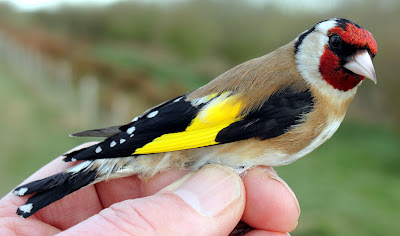If Saturday was a day for Goldfinches then today wasn’t. Read on, but first news of a Barn Owl, the victim of a passing vehicle, the bird found dead by the roadside at Hambleton on 30th March as reported HERE.
Barn Owl
A notification from the BTO tells me that GC29414 was first ringed 2 miles from Hambleton as a nestling on 26 July 2006, 2442 days or almost seven years before it died.The average lifespan for a Barn Owl is about 4 years, the oldest one known from bird ringing being 15 years of age. So despite GC29419 being a very experienced adult, it still fell victim to a vehicle.
As the BTO remind us - “Each year over 900,000 birds are ringed in Britain and Ireland, by over 2,500 highly trained bird ringers, most of whom are volunteers. Ringing began over 100 years ago to study the movements of birds. While it continues to generate information about movements, it also allows study of how many young birds leave the nest and survive to breed as adults, as well as how many adults live from year to year and how many birds disperse to different breeding sites. Collection of this information helps understand why populations increase or decline - vital information for bird conservation. After over a hundred years of bird ringing in Britain and Ireland there is still much more to learn!”
With more northerly wind this morning but after Saturday’s success I decided to try my luck again at the feeding station. When I arrived a Barn Owl was hunting the fields, even flying about my ringing station where soon I would find out there weren’t any new migrants and even the Goldfinches mostly absent.
Barn Owl
Just three Goldfinches this morning, and as if to reinforce the previous point about “still much to learn”, one of the Goldfinch bore a ring D130275 from elsewhere. I suspect it may be from across the other side of Morecambe Bay as a recent Goldfinch control here, D137544 had been ringed last autumn at Heysham some 20kms away.
Goldfinch D137544 - Heysham 22nd Oct 2012 to Out Rawcliffe 28th Feb 2013
Goldfinch
The 7 birds caught today, 3 Goldfinch, 2 Dunnock, 1 Willow Warbler and surprise, surprise, a recapture of the Little Bunting first ringed here on 13th March. Upon examination I aged it once again as a second calendar year female. The bird now has more colouration in the face with the whitish eye ring more conspicuous. I reckon by now the poor creature is well and truly lost and therefore highly unlikely to find a route to north-east Europe or northern Asia where it should be now. Even less likely is that it will find a mate here in the wilds of the Lancahire mosses.
Little Bunting
Little Bunting
Not much doing on the migration front with a single Lesser Whitethroat singing nearby, one Lesser Redpoll over and several Swallows heading north. The 18/20 Whimbrel in the next fields have been there some days now and if only I could get as close to a Whimbrel here in Lancashire as the one I photographed in January's Fuerteventura holiday.
Whimbrel
Otherwise stuff - 4 Yellowhammer in song, 7+ Whitethroat, 6+ Willow Warbler, 15 Tree Sparrow, 8 Corn Bunting, 4 Reed Bunting, 2 Buzzard, 2 Wheatear and 2 Kestrel.
Yellowhammer
It has been cold for weeks now but I know for sure things will warm up soon on Another Bird Blog, so log in later to see why.
Meanwhile take a look at Stewart's gallery down in Australia where it just has to be warmer than here - http://paying-ready-attention-gallery.blogspot.com.au/
Meanwhile take a look at Stewart's gallery down in Australia where it just has to be warmer than here - http://paying-ready-attention-gallery.blogspot.com.au/
















































































